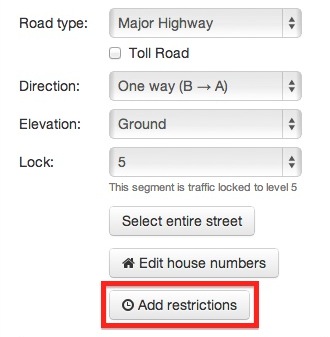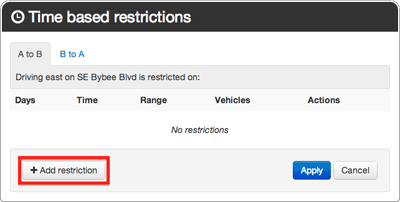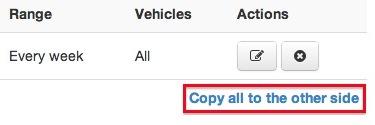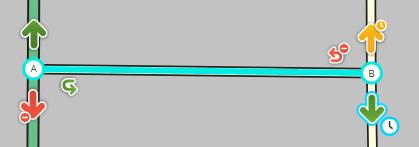Einleitung
Straßen können aus verschiedenen Gründen temporär, oder komplett gesperrt sein, in einer oder beiden Richtungen:
- Baustellen
- Naturkatastrophen
- Örtliche Veranstaltungen
Unter Umständen kann eine Straße für Stunden, Tage, Wochen oder Jahre gesperrt werden. Aufgrund der Länge einer Sperrung entscheiden wir, wie die Karte angepasst wird.
Stunden, Tage, Wochen
Wenn die Sperre nur für ein paar Stunden oder auch ein paar Wochen besteht, dann benütze die Funktion Melden > Sperrung in der Waze-App. Du musst Dich dazu vor Ort befinden, um eine Sperrung über die App zu melden.
Der beste Weg um eine Sperre einzutragen ist das dafür vorgesehene Formular zu nutzen DACH - Straßensperren.
Monate, Jahre
Wenn eine Straße für längere Zeit gesperrt ist, aufgrund einer Langzeitbaustelle oder anderer Gründe, ist es das Beste eine zeitliche Beschränkung einzurichten. Diese können auch für nur eine Richtung eingerichtet werden (z.b. bei temporären Einbahnstraßen)
Täglich für bestimmte Stunden
Ist eine Straße täglich oder an mehreren Tagen für eine gewisse Zeit gesperrt, ist es das Beste mit zeitlich beschränkten Abbiegeverboten zu arbeiten, Informationen dazu findest Du weiter unten.
Anmerkung zur Dauer aller Sperrungen
Im Moment werden die Karten täglich aktualisiert, auf allen Infrastrukturen. Abhängig davon, wann Du die Sperrung bearbeitet hast, ist die Änderung schon innerhalb 2 Tage auf der Karte der Waze-App enthalten. Eingerichtete Sperren (sogenannte Closures) sind sofort aktiv, ohne Update.
- Wenn nur eine Spur gesperrt ist, muss die Karte nicht angepasst werden.
- Wenn eine Straße langsamer befahren wird als sonst, wird Waze die Geschwindigkeiten nach unten korrigieren und ggf. automatische Meldungen anzeigen.
- Wenn es eine Umfahrung gibt, wird Waze lernen, wenn Du da entlang fährst.
- Du musst alle anschließenden Straßen kontrollieren, ob sie auch korrekt bearbeitet sind (Richtungen und Abbiegungen), damit Waze eine optimale Route finden kann.
Zeitlich beschränkte Fahrverbote
Zeitlich beschränkte Abbiege- oder Fahrverbote ermöglichen Waze das Routing von Fahrzeugen durch Abbiegungen oder Straßen zu steuern. Dies kann basierend auf Zeit, spezifischen Tagen oder (in Zukunft) Fahrzeugtypen beschränkt werden. Klassische Beispiele sind Spuren für öffentlichen Verkehr, Abbiegeverbote während Hauptverkehrszeiten, Richtungsänderungen, saisonale Sperrungen, bewegliche Brücken oder Fährverbindungen.
- Fährverbindungen können als Mautstraßen definiert sein und gleichzeitig mit beschränkten Fahrverboten markiert sein, abhängig von den Betriebszeiten. Schau dazu in die länderspezifischen Wikis.
- Feldwege, die nicht für den öffentlichen Verkehr frei sind, brauchen keine zeitlich beschränkten Fahrverbote. Diese sind als Privatstraße zu definieren.
- Privatstraßen sind Privatstraßen, auch diese sind nicht mit zeitlich beschränkten Fahverboten zu versehen.
- Informationen zu Privatstraßen findest Du hier
Übersicht
Es gibt 3 verschiedene Methoden um den Verkehrsfluß zu steuern:
- Mega events
- Temporäre Straßensperrungen in der App oder im Editor
- Zeitlich beschränkte Abbiegeverbote
Zeitlich beschränkte Fahrverbote basieren auf:
- Einem Segment, das den Verkehrsfluß in eine oder beide Richtungen steuert
- Spezifischen Abbiegungen von einem auf ein anderes Segment
Beide können weiter beschränkt werden basierend auf Kombinationen von:
- Tageszeit, Wochentag oder spezifischen Datumsbereich
Beispiele:
- Keine PKWs erlaubt zwischen 09.00h - 15.00h
- Abbiegen verboten zwischen 07.00h - 09.00h und 16.00h - 18.00h an Werktagen
- Fahrbahnen die tageszeitabhängig ihre Fahrtrichtung ändern
Es ist sehr wichtig, dass die Beschränkungen sehr sorgfälltig definiert werden, damit keine fehlerhaften Routings entstehen. Kontrolliere sie lieber zweimal, so ersparst Du den Wazern auf der Straße unnötigen Ärger.
Segmente

Wenn kein Verkehr durch ein Segment (Straße) läuft oder bestimmte Fahrzeugtypen nicht erlaubt sind, kannst Du die Beschränkung direkt für das betreffende Segment definieren. Dies ist einfacher, als jede Abbiegung, die von anderen Segmenten auf das Segment führt einzeln zu verbieten. Manche Beschränkungen betreffen nur eine Fahrtrichtung, oder die Fahrtrichtung ändert in die Gegenrichtung zu einer bestimmten Tageszeit.
Beschränkungen können über die Schaltfläche "Beschränkung hinzufügen/bearbeiten" bearbeitet werden, oder via Tastaturkürzel T.
Dies öffnet das Bearbeitungsfenster für die Beschränkungen. Segmente, die in beiden Richtungen befahrbar sind zeigen zwei Reiter an: "A nach B" und "B nach A", welche sich auf die Richtung der Segmente beziehen. Buchstaben A und B für das ausgewählte Segment.
Der Text unterhalb bezieht sich auf das ausgewählte Segment

Klicke auf die Schaltfläche "Beschränkung hinzufügen" um eine neue Beschränkung hinzuzufügen.
Schau unter Beschränkung hinzufügen, um mehr Informationen zu erhalten. Du kannst mehrere Beschränkungen pro Segment hinzufügen, für verschiedene Tageszeiten oder Wochentage.

Wenn Du die Beschränkung erfasst hast, kannst Du sie auch ganz leicht für die Gegenrichtung kopieren. Benutze dazu die Schaltfläche "Kopiere gleiche Beschränkung für die Gegenrichtung". Ansonsten wird die Beschränkung nur für eine Richtung gültig sein.
Wenn eine Beschränkung erstellt wurde, kannst Du sie bearbeiten ![]() oder entfernen
oder entfernen ![]() mit der entsprechenden Schaltfläche.
mit der entsprechenden Schaltfläche.
Mehrfachauswahl von Segmenten
Du kannst auch mehrere Segmente gleichzeitig mit einer Sperrung belegen. Halte die Ctrl-Taste (Cmd auf Mac) und wähle die Segmente aus, oder verwende das Tastaturkürzel m.
Ein paar Sachen, die Du beachten musst bei einer Mehrfachauswahl:
- Achte auf Einbahnstraßen.
- Segmente können Unterschiedliche Erstellrichtungen besitzen A->B oder B->A
- When multiple segments are selected with different restrictions set on them, they will appear in a different section of the panel under the title: 'These restrictions only apply to some of the segments selected:' Click the ‘Apply to all’ link to the right of the restriction line to propagate the restriction to all the selected segments.
Abbiegungen
Wenn nur einzelne Abbiegungen nicht erlaubt sind, halte Dich an die folgenden Anweisungen.
Alle Abbiegungen zu jeder Zeit verbieten
Abbiegungen, die für alle Fahrzeuge zu jeder Zeit verboten sind, erhalten einen roten Pfeil. Sie brauchen keine zeitlich beschränkten Abbiegverbote.
Klick einfach auf den grünen Pfeil und er ändert auf rot.
- Informationen zu den Abbiegungen findest Du hier.
Zeitlich beschränkte Abbiegeverbote
Wenn einzelne Abbiegungen nicht zu jeder Zeit oder für alle Fahrzeuge verboten sind, kannst Du diese Abbiegungen von Segment zu Segment beschränken. Das gleiche gilt für Abbiegungen, die für alle Fahrzeuge nur zu bestimmten Zeiten verboten sind.
Um eine Beschränkung hinzuzufügen, fahre mit der Maus auf den gewünschten Pfeil. Klick auf das Uhr-Logo und das Bearbeitungsfenster öffnet sich.
![]() Die Uhr erscheint nur auf grünen Pfeilen.
Die Uhr erscheint nur auf grünen Pfeilen.
Klick auf den Button "Beschränkung hinzufügen".
Schau unter Beschränkung hinzufügen, wie man diese genau definiert. Du kannst einer Abbiegung mehere Beschränkungen für verschiedene Tageszeiten oder auch Wochentage zuweisen.
Wenn Du die Beschränkungen definiert hast und "Übernehmen" angeklickt hast, siehst Du einen gelben Pfeil. Das bedeutet, dass die Beschränkung nun aktiviert ist. Speichern nicht vergessen.
Um das Bearbeitungsfenster für eine bestehende Beschränkung zu öffnen, musst Du einfach wieder auf die Uhr klicken. Wenn Du nur den gelben Pfeil anklickst, wird er rot. Wenn Du den roten Pfeil nun nochmals anklickst, wird er wieder gelb und die vorher gespeicherten Beschränkungen erscheinen wieder.
Beschränkung hinzufügen
Für Segment- und Abbiegebeschränkungen verwenden wir jeweils das selbe Bearbeitungsfenster. Einmal wird es über die Segment-Eigenschaften geöffnet, das andere Mal über den Abbiegepfeil.
Configure the restriction as required using the guidelines described for each setting.
After configuring the restriction as required, press the Add button on that panel to save the restriction and return to the Time based restrictions panel. Continue adding restrictions in the same way to cover combinations that may only restrict a few house per day, but at different times of day.
Days of week
Select the days of the week that the restriction will be active. Use the Select all or Select none link to to more quickly change all the check boxes. The default is all days of the week. Your display order for the days will depend upon your country settings in your browser and may not exactly match the image above.
Time of day
For restrictions that apply all day long, use the default setting of All day. If the restriction is for only certain periods of time during the day, then select the From radio button to allow the time to be changed. You can click the hours or minutes fields to enter times directly, or click the clock icon next to the time to enable input panels.
The time is entered in 24-hour format, meaning AM and PM are not used. To convert from 12 hour time to 24 hour time, use the following table:
| 12 hour time | 24 hour time | How? |
|---|---|---|
| 12:00 AM (midnight) - 12:59 AM | 0:00 - 0:59 | subtract 12 from hour |
| 1:00 AM - 11:59 AM | 1:00 - 11:59 | do nothing |
| 12:00 PM (noon) - 12:59 PM | 12:00 - 12:59 | |
| 1:00 PM - 11:59 PM | 13:00 - 23:59 | add 12 to hour |
Minutes, of course, remain the same.
For example, a schedule of 10:00 AM to 3:00 PM would instead be entered as 10:00 to 15:00; a schedule of midnight to noon (12:00 AM to 12:00 PM) would instead be entered as 0:00 to 12:00.
The time that should be entered is the local time of the road as would be displayed on the local signs. The Waze server already knows the local time zones and will schedule the restriction correctly.
Daylight savings time is automatically accounted for as long as the Waze client app is properly set to the correct local time.
Entering midnight
If a scheduled restriction is between 8:00 PM and Midnight, then enter "20:00 - 23:59". Technically you can also enter "20:00 - 00:00" to get the same result.
Crossing midnight
If a restriction occurs only during night time hours and opens in the morning e.g., restricted between 10 PM and 5 AM, then enter the From time as 22:00 and the To time as 05:00. You will notice an information box that says the restriction will end of the following day. If this restriction is only on a certain day of the week, e.g., Saturday night and Sunday night, then select the day of the week for Sat and Sun matching the start of the restriction. There is no need to include Monday because it will be automatically covered. Including the Monday check box would then add a third day starting at 10 PM Monday.
Date range
The default setting is Every week meaning there is no limit to the date range so as soon as you add the restriction it will be active every week until it is removed. Optionally you can select the radio button for Range of dates to limit the restriction to a certain number of days. Press the button displaying the date to display two calendars. The one one the left shows the start date and the calendar on the right shows the end date of the restriction. Note these date are inclusive meaning the restriction will include both dates (and all the ones in between) when determining the restriction. When you have selected the date range press the green Apply button. The date range is displayed in DD/MM/YYYY format. To remove the date range, simply select the Every week radio button again.
Again the end date will consider the entire day based on any time settings also configured. If the time crosses midnight, the next day will automatically be included for that time period and then the restriction will no longer be active after that ending time.
Vehicle type
There are some situations that only restrict certain vehicle types from passing through the turn or segment. Examples of this include no truck zones.
((Insert some photos of real-world signs))
Also, some turns may be taken by no traffic except certain vehicles. Examples of this include HOV lanes, bus stops, and truck-only exit ramps. For example, for an HOV-2 restricted road, you might check all vehicle types except public transportation, HOV-2, HOV-3, and motorcycles.
((Insert some more photos))
The default condition is All vehicle types are included in the restriction, but if only certain vehicles are going to be restricted, press the (Edit) link next to Restriction for all vehicle types to bring up the vehicle type selector.
Add a check mark only the vehicles that are not permitted during the restriction period and leave the other types unchecked. Use the Select all or Select none link to change all the check boxes.
REMEMBER: These are restrictions. The selected vehicle types will be restricted. The unselected vehicle types will be admitted.
NOTE: The Waze client app does not differentiate between different vehicle types, so these settings do not have any affect on routing.
Text Description
Leave a description for the nature of the restriction. If the restriction is the result of signs or markings, make note of this. If the restriction is the result of construction or road work, leave details about the closure.
NOTE: There is a 100-character limit in the Description field. Entering more than that will result in a "General Error" upon trying to save.
Examples
The following examples cover specific situations to provide more guidance. Some of the examples below will be turn based restrictions, but the method is the same for the segment restrictions.
Date range results
The following table includes example date range combinations and the resulting restrictions that it would generate:
| Days of the week | Time Range | Date Range | Restriction Result |
| Sunday | All day | 12.1.2014 - 12.31.2014 | Every Sunday on December 2014, from 00:00 until 23:59:59. |
| Monday - Friday | 09:00-11:00 | Every Week | Every weekday from 9am to 11am. |
| Thursday | 23:00-03:00 | Every Week | Every Thursday from 23:00 until every Friday at 03:00 |
| All | All day | 7.3.2015 - 7.15.2015 | From July 3rd 2015 at 00:00 until July 15th at 23:59:59 |
Simple time based restrictions
For a turn or segment that is restricted (not allowed) between 10 am and 2 pm daily, click the radio button next to "From", then enter "10:00" and "14:00" as the start and end times of the restriction.
Click "Add" to add the restriction. You will be returned to the Time based restrictions panel. The panel should now reflect the added restrictions.
For a turn that is restricted between 7 and 9 am, and again between 4 and 6 pm, add the restrictions one-by-one as instructed above. When added, the panel should look like this.
((Insert image of panel with 7-9 and 16-18 restrictions added - n peters to bienville example))
Overnight time based turn restrictions
Time-of-day restriction periods may cross midnight. For a turn that is restricted between 8 pm and 6 am, enter the From time as 20:00 and the To time as 6:00.
((Insert image of panel with 20-23:59 and 0-6 restrictions added - bourbon street example))
Date-based turn restrictions
Some restrictions may also only be in place on certain days of the week. For a turn that is restricted "weekends", check only the boxes for "Sat" and "Sun".
Time-and-date-based turn restrictions
For a turn that is restricted "2 pm to 4 pm, weekdays", when adding the restriction, uncheck the boxes next to "Sat" and "Sun", and enter "14:00" and "16:00" in the time boxes.
Time-of-year and holiday turn restrictions
Some restrictions may only be in place during certain times of year. If on a specific date and time, set the appropriate combination.
At this time, there is no way to schedule a yearly repeating holiday restriction. You must enter each year manually.
Reversible road
Reversible roads are roads whose travel direction depends on the time of day, to allow more lanes of travel into or out of a city in order to handle the additional vehicle load during rush hours.
On the Waze map, a reversible road is set up as a 2-way road, and then the allowed travel directions are set up as restrictions. This is a bit tricky because Waze uses the idea of restrictions, which is the opposite of allowed. For example, say a road allows travel northbound only between the hours of 6AM to 11AM. Those are the allowed hours of travel that direction. In the Waze restrictions setup, we would have to ensure that travel in that direction is restricted from 11:01AM to 5:59AM.
Reversible roads with vehicle type restrictions
Some reversible roads may also be restricted to certain vehicle types. A common example of this is the reversible HOV lane.
Some cities have reversible roads set up that are also HOV lanes. Two examples are in Seattle and are the I-90 and I-5 Express Lanes. These lanes reverse travel direction depending on the time of day, but these lanes are also HOV lanes, so you aren't allowed on them unless your vehicle meets the requirements.
Below are the current setup for the I-5 Express Lanes in Seattle, WA, based on published schedules by the Washington Department of Transportation.
While the WSDOT webpage is very simple what the schedule is, only having two entries, to translate that into restrictions is much more complicated.










